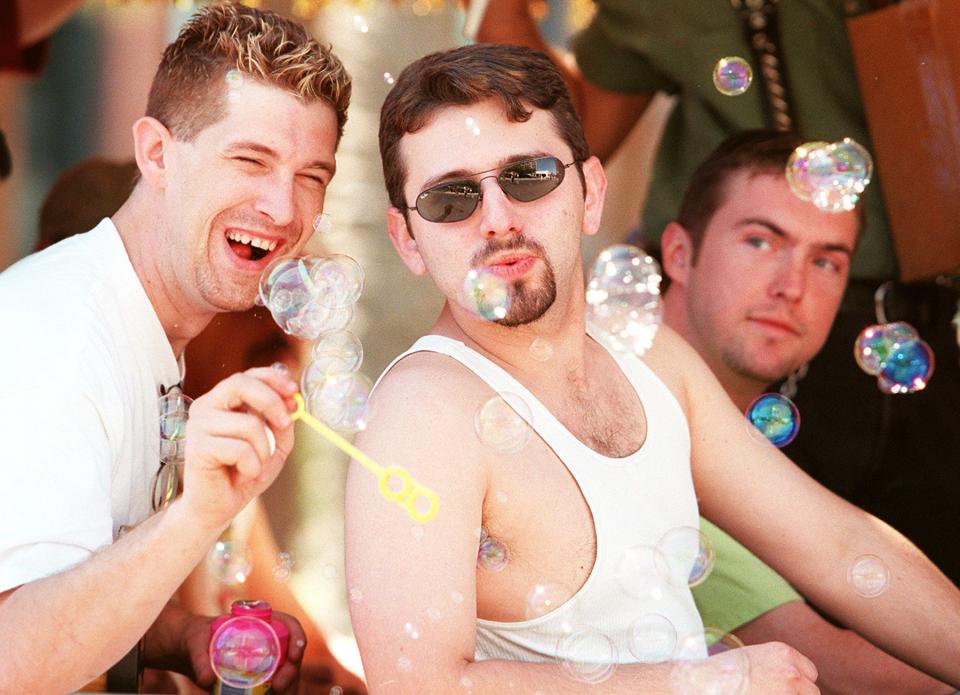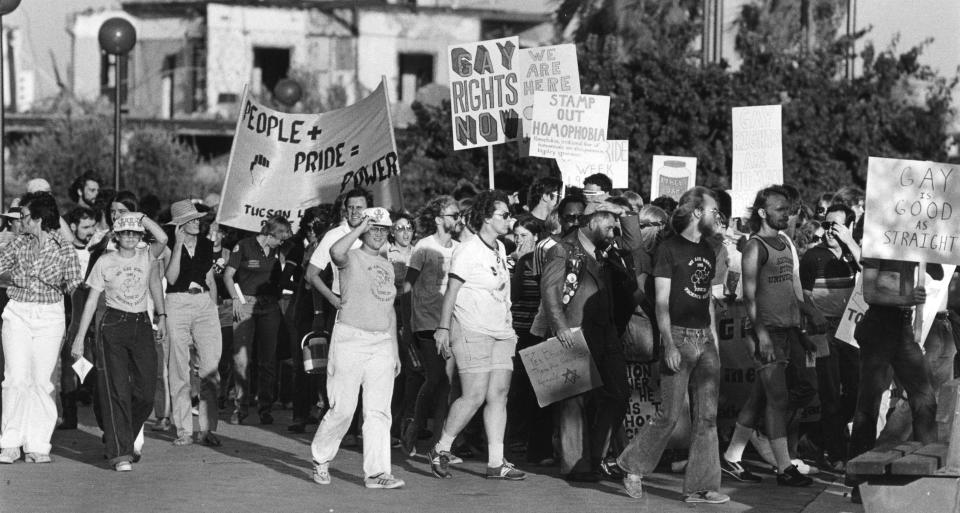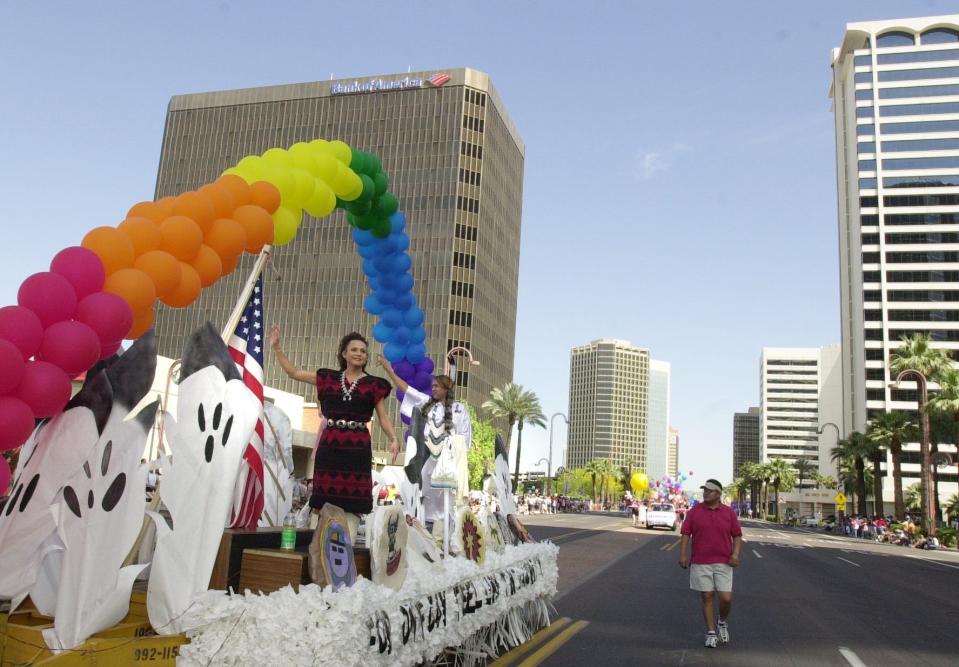'Before I knew it, I was walking': Original Phoenix Pride marcher recalls event's history
- Oops!Something went wrong.Please try again later.
Ernie Mendoza recalled June 27, 1981 not being as hot a summer day as what the Valley is now used to.
On that Saturday, Mendoza was a spectator of the grassroots Phoenix Gay and Lesbian Pride March. At 23 years old, he had not come out as gay yet. But something compelled him to join the crowd of about 100 people walking to the Arizona state Capitol.
"I thought this was awesome. Before I knew it, I was walking in it. I just didn’t even think about it. I just got into the march," Mendoza, now 65, said. The march "brought out the pride in me to be who the hell I am."
The march — Phoenix’s first Pride event — eventually included about 650 demonstrators, The Arizona Republic reported at the time. Now, the nonprofit Phoenix Pride draws up to tens of thousands to its annual parade and festival.
Drawing from The Republic’s archives, interviews with Mendoza and Phoenix Pride representatives, along with the organization’s records, here is a look at the history of Pride's activism and celebrations in the Valley.
1969 uprising originated Pride worldwide
Though Phoenix Pride now holds its main events in the fall, Pride month has been federally recognized throughout June since 1999.
Many demonstrations, like Phoenix’s 1981 march to the state Capitol, were organized to commemorate the three-day Stonewall riots in New York. Patrons at the Stonewall Inn clashed with the New York Police Department during a violent June 28, 1969 raid on Stonewall Inn, a gay bar. Stonewall then propelled the gay rights movement.
Pride Month also coincides with United States Supreme Court decisions affecting LGBTQ+ rights — the decriminalization of same-sex sexual relations in June 2003 and the protection of same-sex marriage in June 2015.

Pride in Phoenix pushed back on anti-LGBTQ+ legislation
Mendoza said the 1981 Pride march protested state legislators trying to close the only meeting places available to LGBTQ+ Arizonans — a few gay bars in operation and adult bookstores.
"There was no outlet, so when you have to hide, you find whatever comfort zone you can," Mendoza said of the importance of these establishments.

In the early 1980s, same-sex sexual relations were criminal in Arizona and punishable by up to 30 days in jail or a $500 fine.
As such, the marchers began hitting the pavement at Patriots Square Park. Led by a banner reading "We are here," their destination was the state Capitol. Mendoza said demonstrators were "tired of being ignored."
Police said 3,000 supporters who did not march were on Capitol grounds that day, according to Mendoza. The media was instructed by organizers to not photograph the spectators as there were fears they would be recognized and lose their jobs, Mendoza said.
Phoenix Pride spokesperson Jeremy Helfgot called the 1981 march "that very first moment of visibility" in Arizona.
LGBTQ+ residents would come to embrace the festival’s openness, drawing more than 10,000 attendees in 1993 with 87 commercial and educational booths.
The two-day Pride festival "is a 'safe zone' for us one weekend out of the year," college student Skip Schrader was quoted as saying in a June 5, 1994 article in The Republic. Some attendees donned "leather-studded gear" and others were in drag, the article said.
A 1998 article about the festival in The Republic mentioned same-sex couples kissing under mesquite trees as families with children passed by.
Events’ time-of-year and city changes

Pride organizers in 1990 formed a committee to oversee a booth and entertainment festival that debuted at El Lienzo Charro Rodeo Grounds in south Phoenix.
Mendoza had immersed himself in Phoenix’s Pride marches and rallies, joining the committee in 1991, the same year the festival moved to Kiwanis Park in Tempe. In the subsequent six years, Pride festivalgoers would converge at Tempe’s Diablo Stadium.
Sometime in the early to mid-1990s, Mendoza won the festival’s first major sponsorship through Budweiser, which helped generate much-needed revenue.
The City of Tempe was consistently welcoming of the Pride festival, Mendoza said.
The city’s inclusiveness became more apparent when voters in 1994 elected Neil Giuliano, one of the country’s first openly gay mayors. The city waived $1,500 in stadium rental fees for the 1997 festival’s organizers in the face of critics, including a local Christian fundamentalist group, according to reporting by The Republic.
But since Tempe lacked a centralized location for the region’s residents, Margaret T. Hance Park in Phoenix was selected in 1998 as the festival’s new setting.
"(Tempe officials) really wanted us there. They were all sad that we moved to Phoenix ... (but) we couldn't bring in a crowd," said Mendoza, who in 1996 became the committee’s first Latino president.
Sweltering summers also hampered Pride festival attendance.
"We had lost money several times because the heat was just unbearable," Mendoza said.
The Pride festival’s date was moved to April in 1998 and coincided with a parade that had been started by the committee just the year before. More than 12,000 people were expected to show up at the festival, according to The Republic’s reporting at the time.
Festival, parade find new setting, new season
Mendoza stepped down as committee president in 2001 before Steele Indian School Park became the festival’s home in 2003.
After the pandemic suspended Phoenix’s two principal Pride events in 2020, the festival and parade took place the following year in early November. This was the first time either event happened in the fall. And in 2022, Phoenix’s Pride festival and parade fell on a mid-October weekend.
October is the anticipated long-term month for Phoenix Pride festivities, said Helfgot, the organization's spokesperson. According to Helfgot, an excess of 50,000 and 10,000 people make it annually to the festival and parade, respectively.
Phoenix Pride has provided the Valley’s LGBTQ+ residents with more than $1 million in community grants and individual scholarships, according to Helfgot.
LGBTQ+ performers like RuPaul, Aaron Carter, actress Heather Matarazzo and actor Wilson Cruz have made their way to Phoenix’s Pride celebrations as performers or keynote speakers. Musicians popular with LGBTQ+ audiences, including the B-52s, Belinda Carlisle, Jennifer Holliday, Sheena Easton, Maribel Guardia and Ninel Conde, have taken the stage during Phoenix Pride events.
Phoenix Pride’s grand marshals have included Phoenix Mercury center Brittney Griner in 2014 and "Wonder Woman" TV series star Lynda Carter in 2011.
Mendoza said Pride events in Phoenix have allowed the LGBTQ+ community to not only be seen, as the 1981 march sought to do, but it also empowers the community members to see themselves. While gay bars endured bigotry, Mendoza added that Pride is transformative to LGBTQ+ identity.
"You see people at bars, OK. You’re in the dark. You don’t get to know a whole lot of people. But when you see people in the light, it changes everything. It changed a lot for me," Mendoza said.
Reach breaking news reporter Jose R. Gonzalez at jose.gonzalez@gannett.com or on Twitter @jrgzztx.
Support local journalism. Subscribe to azcentral.com today.
This article originally appeared on Arizona Republic: Original Phoenix Pride marcher remembers event's early days

